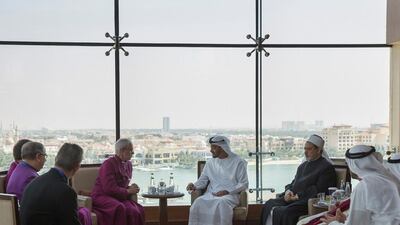ABU DHABI // Sheikh Mohammed bin Zayed, Crown Prince of Abu Dhabi and Deputy Supreme Commander of the Armed Forces, has held a meeting with Dr Ahmed El Tayyeb, Grand Imam of Al Azhar, and Justin Welby, the Archbishop of Canterbury, to discuss coexistence among religions.
The two religious figures were visiting the UAE to attend the Towards an Integrated World conference, organised by the Muslim Council of Elders and with leaders from the Anglican Communion.
Sheikh Mohammed said he hoped their efforts would be crowned with success in furthering tolerance and understanding among religions and sects to live in peace, security and tranquillity.
He exchanged views with them on the issues addressed by the conference to maximise the humanitarian and cultural affairs of nations and peoples, reported state news agency Wam.
Sheikh Mohammed stressed that the UAE, under the leadership of President Sheikh Khalifa, had laid down the rules and principles that reinforced the UAE’s approach to coexistence and equality, the rejection of extremism and violence and countering discrimination and racism.
He called on all parties to unite against the destructive extremist ideas and criminal acts undertaken by terrorist organisations to defame the religions.
The meeting was also attended by Sheikh Abdullah bin Bayyah, president of the Forum for Promoting Peace in Muslim Societies, Dr Ali Al Nuaimi, secretary-general of the board of trustees of the Muslims Council of Elders, Mohammed Mubarak Al Mazrouei, Under Secretary of the Crown Prince’s Court of Abu Dhabi, and other officials.
At the conference, it was agreed Muslim and Christian youth must work together towards common goals of peace and equality.
“There is a new sectarian mentality going on. It has led to the politicisation of certain issues which are in nature not like that,” said Dr Hasan Al Shafi’i of the Muslim Council of Elders.
“There is a distancing between youth on both sides, from coexistence, as each one of them goes into his own world, his own mosque and church, instead of working together and co-living.”
This coexistence would help build understanding and trust between the faiths, he said.
“It has happened in Egypt and in the Arab world in the past. Muslim and Christian youth used to sit together to work towards this but no longer do, and this has led to their isolation,” said Dr Al Shafi’i.
“Now, we need to look at these issues that have sometimes expanded into regional and national massacres and wars in some parts of the Middle East.”
He said that ISIL was a result of that isolation.
“Last November, Christians in Iraq tried to go back to their homes in Mosul but local authorities prohibited them,” he said.
“The way ISIL dealt with them and the [Yazidis] is brutal and there are a lot of violent movements happening in this region, especially in multi-ethnic cultures like Iraq and Syria.
“We have to put out those fires and make sure to work hard to bring our Christian brothers back to their homes and lands.”
“Political use of faith hinders coexistence. It is destructive when politicians seek to use religion to their own end,” said Bolly Lapok, Bishop of Kuching in Malaysia and a member of the Anglican Communion.
He said a way forward would be to build a relationship with those of other faiths, especially with Muslims.
“Islam and Christianity have their own views,” said Dr El Tayyeb. “It is a matter of dialogue because it is one of the main components of the course of faith.”
Archbishop Welby said the aim of such a dialogue was to enable people to discern where they agree and disagree.
“What we have to do is find areas of dialogue to see first where we can contribute to the common good together, especially in areas where all religious groups are a minority,” he said.
“Our common humanity calls us to love for the poor, weak, marginalised and the suffering.”
cmalek@thenational.ae

